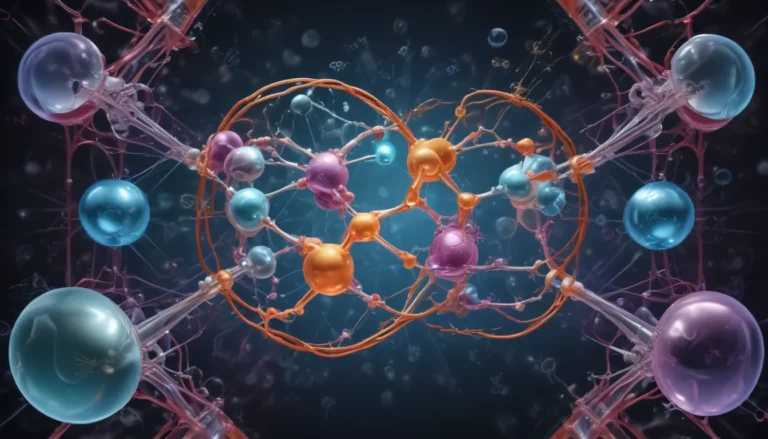A Note About Images: The images used in our articles are for illustration purposes only and may not exactly match the content. They are meant to engage readers, but the text should be relied upon for accurate information.
Amides are a class of organic compounds that have a significant impact on various aspects of our lives, ranging from medicine to industry. These versatile molecules are derived from carboxylic acids and possess unique properties that make them integral to several fields, including chemistry and biology. In this article, we will uncover nine intriguing facts about amides that will deepen your understanding of these compounds and highlight their importance in different applications. Let’s embark on a journey to explore the captivating world of amides and uncover some surprising aspects that you may not have known before.
Unveiling the Versatility of Amides
Amides, characterized by a carbonyl group bonded to a nitrogen atom, belong to the realm of organic compounds. These compounds play a crucial role in various industries such as pharmaceuticals, plastics, and agrochemicals. Their versatility and diverse applications make them indispensable building blocks in the synthesis of drugs, polymers, and other organic compounds.
Exploring the Unique Properties of Amides
Amides exhibit a wide range of physical and chemical properties, depending on their molecular structure. They can exist in solid, liquid, or gas form at room temperature and have varying solubilities in different solvents. These properties make them highly adaptable to different environments and applications.
Essential Role of Amides in Drug Synthesis
Amides are essential components in the synthesis of numerous drugs, including antibiotics and painkillers. Their stability and ability to interact with biological targets make them invaluable in drug design and development. The presence of amide functional groups in pharmaceutical compounds underscores their critical role in medicine.
Amides: The Building Blocks of Proteins
Proteins, the building blocks of life, are composed of amino acids linked together by peptide bonds, which are essentially amides. These peptide bonds impart proteins with their unique structure and functionality, making them essential for various biological processes in living organisms.
Amides in the Polymer Industry
Amides find widespread use in the polymer industry as monomers in polymer synthesis. They contribute to the properties of polymers by enhancing their strength, flexibility, and resistance to heat and chemicals. Notable examples of amides used in polymer production include nylon and polyacrylamide.
Crucial Role of Amide Bonds in DNA Replication
In the realm of genetics, amide bonds play a pivotal role in DNA replication. The backbone of DNA comprises a sugar-phosphate chain connected by phosphodiester bonds, which are essentially amide bonds. These bonds ensure the stability and integrity of the DNA molecule during the intricate process of replication.
Diverse Methods of Amide Synthesis
Amides can be synthesized through various methods, such as the reaction between an acid chloride and an amine or the reaction between an acid anhydride and an amine. These diverse synthetic routes enable the production of a wide array of amide compounds with varying properties and functionalities.
Naming Conventions of Amides
The nomenclature of amides is based on the substituents attached to the nitrogen atom. For instance, an amide with a methyl group attached to the nitrogen atom would be named N-methylamide. This naming system facilitates the accurate description of the molecular structure of different amide compounds.
Physiological Effects of Amides
Amides can exhibit a range of physiological effects on the human body, with some acting as local anesthetics, anti-inflammatory agents, or analgesics. Understanding these physiological effects is crucial in the development of new drugs and therapeutic treatments that harness the therapeutic potential of amides.
Conclusion: Embarking on a Journey of Discovery
Amides stand as fascinating compounds with multifaceted roles in various realms of chemistry. Their applications in pharmaceuticals, polymers, and organic synthesis underscore their significance in shaping modern industries. By unraveling the unique properties and behaviors of amides, researchers and chemists can make groundbreaking discoveries that drive innovation in diverse fields.
From their pivotal role in peptide bonds to their capacity to form hydrogen bonds, amides offer a realm of possibilities for scientific exploration and development. By gaining a deeper understanding of the chemical intricacies of amides, scientists can usher in new innovations that hold the potential to revolutionize medicine, materials science, and other disciplines.
FAQs: Unveiling the Mysteries of Amides
- What are amides?
-
Amides are organic compounds derived from carboxylic acids, featuring an amine group (-NH2) and a carbonyl group (-C=O) linked by a nitrogen atom.
-
What are the uses of amides?
-
Amides serve various purposes, acting as intermediates in pharmaceutical synthesis, components in polymer production, and solvents or reagents in organic chemistry reactions.
-
How do amides participate in hydrogen bonding?
-
Amides form hydrogen bonds due to the presence of nitrogen and oxygen atoms in the functional group. These bonds are crucial for maintaining the structural integrity of proteins.
-
Can amides be found in nature?
-
Yes, amides are naturally occurring compounds and are essential components of proteins, playing a vital role in the biological functions of living organisms.
-
Do amides exhibit isomerism?
- Amides can exhibit different types of isomerism, including structural and stereoisomerism. The presence of distinct substituents leads to structural isomers, while varied arrangements around the nitrogen atom result in stereoisomers.
Embark on a journey of discovery and delve into the fascinating realm of amides, where science meets innovation and possibilities abound. Unveil the mysteries of these compounds and explore the captivating world of organic chemistry with a curious mind and a thirst for knowledge. Join us in unraveling the secrets of amides and unlocking the potential they hold for shaping the future of science and technology.
Your Feedback Matters
We value your input and strive to provide accurate and engaging content that enriches your learning experience. Each fact on our platform is contributed by individuals like you, ensuring a diverse and insightful collection of information. Our dedicated editors meticulously review each submission to uphold the highest standards of accuracy and reliability. Explore, learn, and engage with confidence as you discover new horizons of knowledge with us.






